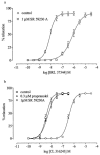Evidence against beta 3-adrenoceptors or low affinity state of beta 1-adrenoceptors mediating relaxation in rat isolated aorta
- PMID: 12522078
- PMCID: PMC1573643
- DOI: 10.1038/sj.bjp.0705017
Evidence against beta 3-adrenoceptors or low affinity state of beta 1-adrenoceptors mediating relaxation in rat isolated aorta
Abstract
1 The presence of beta(3)-adrenoceptors and the low affinity state of the beta(1)-adrenoceptor (formerly "putative beta(4)-adrenoceptor") was investigated in ring preparations of rat isolated aorta preconstricted with phenylephrine or prostaglandin F(2alpha) (PGF(2alpha)). Relaxant responses to isoprenaline, selective beta(3)-adrenoceptor agonists (BRL 37344, SR 58611A, CL 316243) and non-conventional partial agonists (CGP 12177A, cyanopindolol, pindolol) were obtained. 2 In phenylephrine-constricted, but not PGF(2alpha)-constricted rings, relaxations to isoprenaline showed a propranolol-resistant component. 3 In phenylephrine-constricted rings, relaxations to BRL 37344 (pEC(50), 4.64) and SR 58611A (pEC(50), 4.94) were not antagonized by the selective beta(3)-adrenoceptor antagonist SR 59230A (< or =1 microM). CL 316243 (< or =100 microM) failed to produce relaxation. In PGF(2alpha)-constricted rings only SR 58611A produced relaxation, which was not affected by SR 59230A (< or =3 microM). 4 Non-conventional partial agonists produced relaxation in phenylephrine-constricted but not PGF(2alpha)-constricted rings. The relaxation to CGP 12177A was unaffected by SR 59230A (< or =1 microM) or by CGP 20712A (10 microM), reported to block the low affinity state of the beta(1)-adrenoceptor. 5 beta-adrenoceptor antagonists also produced relaxation in phenylephrine-constricted rings with an order of potency of (pEC(50) values): bupranolol (5.5) approximately 38;SR 59230A (5.47) approximately 38;cyanopindolol (5.47)>pindolol (5.30)>alprenolol (5.10)>propranolol (4.83)>ICI 118551 (4.60)>CGP 12177A (4.38) approximately 38;CGP 20712A (4.35). Bupranolol (100 microM), alprenolol (30 microM), propranolol (100 microM) and SR 59230A (10 microM) produced no relaxation in PGF(2alpha)-constricted rings. 6 These results provide no evidence for the presence of functional beta(3)-adrenoceptors or the low affinity state of the beta(1)-adrenoceptor in rat aorta.
Figures



Similar articles
-
Beta 1-, beta 2- and atypical beta-adrenoceptor-mediated relaxation in rat isolated aorta.Br J Pharmacol. 2000 Feb;129(4):637-44. doi: 10.1038/sj.bjp.0703091. Br J Pharmacol. 2000. PMID: 10683187 Free PMC article.
-
ALpha1-adrenoceptor antagonist properties of CGP 12177A and other beta-adrenoceptor ligands: evidence against beta(3)- or atypical beta-adrenoceptors in rat aorta.Br J Pharmacol. 2004 Jun;142(4):781-7. doi: 10.1038/sj.bjp.0705840. Br J Pharmacol. 2004. PMID: 15205310 Free PMC article.
-
Differences between the third cardiac beta-adrenoceptor and the colonic beta 3-adrenoceptor in the rat.Br J Pharmacol. 1996 Aug;118(8):2085-98. doi: 10.1111/j.1476-5381.1996.tb15648.x. Br J Pharmacol. 1996. PMID: 8864547 Free PMC article.
-
Atypical beta-adrenoceptors, different from beta 3-adrenoceptors and probably from the low-affinity state of beta 1-adrenoceptors, relax the rat isolated mesenteric artery.Br J Pharmacol. 2003 Sep;140(1):3-12. doi: 10.1038/sj.bjp.0705421. Epub 2003 Aug 4. Br J Pharmacol. 2003. PMID: 12967929 Free PMC article.
-
Human heart beta-adrenoceptors: beta1-adrenoceptor diversification through 'affinity states' and polymorphism.Clin Exp Pharmacol Physiol. 2007 Oct;34(10):1020-8. doi: 10.1111/j.1440-1681.2007.04730.x. Clin Exp Pharmacol Physiol. 2007. PMID: 17714089 Review.
Cited by
-
Alpha1-, alpha2- and beta-adrenoceptors in the urinary bladder, urethra and prostate.Br J Pharmacol. 2006 Feb;147 Suppl 2(Suppl 2):S88-119. doi: 10.1038/sj.bjp.0706619. Br J Pharmacol. 2006. PMID: 16465187 Free PMC article. Review.
-
Role of beta2-adrenoceptors (beta-AR), but not beta1-, beta3-AR and endothelial nitric oxide, in beta-AR-mediated relaxation of rat intrapulmonary artery.Naunyn Schmiedebergs Arch Pharmacol. 2005 Jul;372(1):14-23. doi: 10.1007/s00210-005-1082-2. Epub 2005 Aug 26. Naunyn Schmiedebergs Arch Pharmacol. 2005. PMID: 16133491
-
Comparison of the alpha-adrenoceptor-mediated effects of beta3-adrenoceptor ligands in rat pulmonary artery.Naunyn Schmiedebergs Arch Pharmacol. 2005 Jun;371(6):535-9. doi: 10.1007/s00210-005-1067-1. Epub 2005 Jul 13. Naunyn Schmiedebergs Arch Pharmacol. 2005. PMID: 16012871
-
Tools to study beta3-adrenoceptors.Naunyn Schmiedebergs Arch Pharmacol. 2007 Feb;374(5-6):385-98. doi: 10.1007/s00210-006-0127-5. Epub 2007 Jan 9. Naunyn Schmiedebergs Arch Pharmacol. 2007. PMID: 17211601 Review.
-
Different β-adrenoceptor subtypes coupling to cAMP or NO/cGMP pathways: implications in the relaxant response of rat conductance and resistance vessels.Br J Pharmacol. 2013 May;169(2):413-25. doi: 10.1111/bph.12121. Br J Pharmacol. 2013. PMID: 23373597 Free PMC article.
References
-
- ARCH J.R.S., AINSWORTH A.T., CAWTHORNE M.A., PIERCEY V., SENITT M.V., THODY V.E., WILSON S. Atypical β-adrenoceptor brown adipocytes as target for anti-obesity drugs. Nature. 1984;309:163–165. - PubMed
-
- ARCH J.R.S., KAUMANN A.J. β3- and atypical β-adrenoceptors. Med. Res. Rev. 1993;13:663–729. - PubMed
-
- BLOOM J.D., DUTIA M.D., JOHNSON B.D., WISSNER A., BURNS M.G., LARGIS E.E., DOLAN J.A., CLAUS T.H. Disodium (R,R) - 5- [2 -[[2- (3-Chlorophenyl)-2-hydroxymethyl]-amino]propyl]-1,3-benzodioxole-2,2-dicarboxylate (CL 316,243). A potent β-adrenergic agonist virtually specific for β3-adrenoceptors. A promising antidiabetic and antiobesity agent. J. Med. Chem. 1992;35:3081–3084. - PubMed
-
- BLUE D.R., BOND R.A., ADHAM N., DELMENDO R., MICHEL A., EGLEN R.M., WHITING R.L., CLARKE D.E. Interaction of dihydroalprenolol and cyanopindolol with atypical β-adrenoceptors in guinea-pig ileum. Br. J. Pharmacol. 1989;96:242P. - PubMed
MeSH terms
Substances
LinkOut - more resources
Full Text Sources
Research Materials

